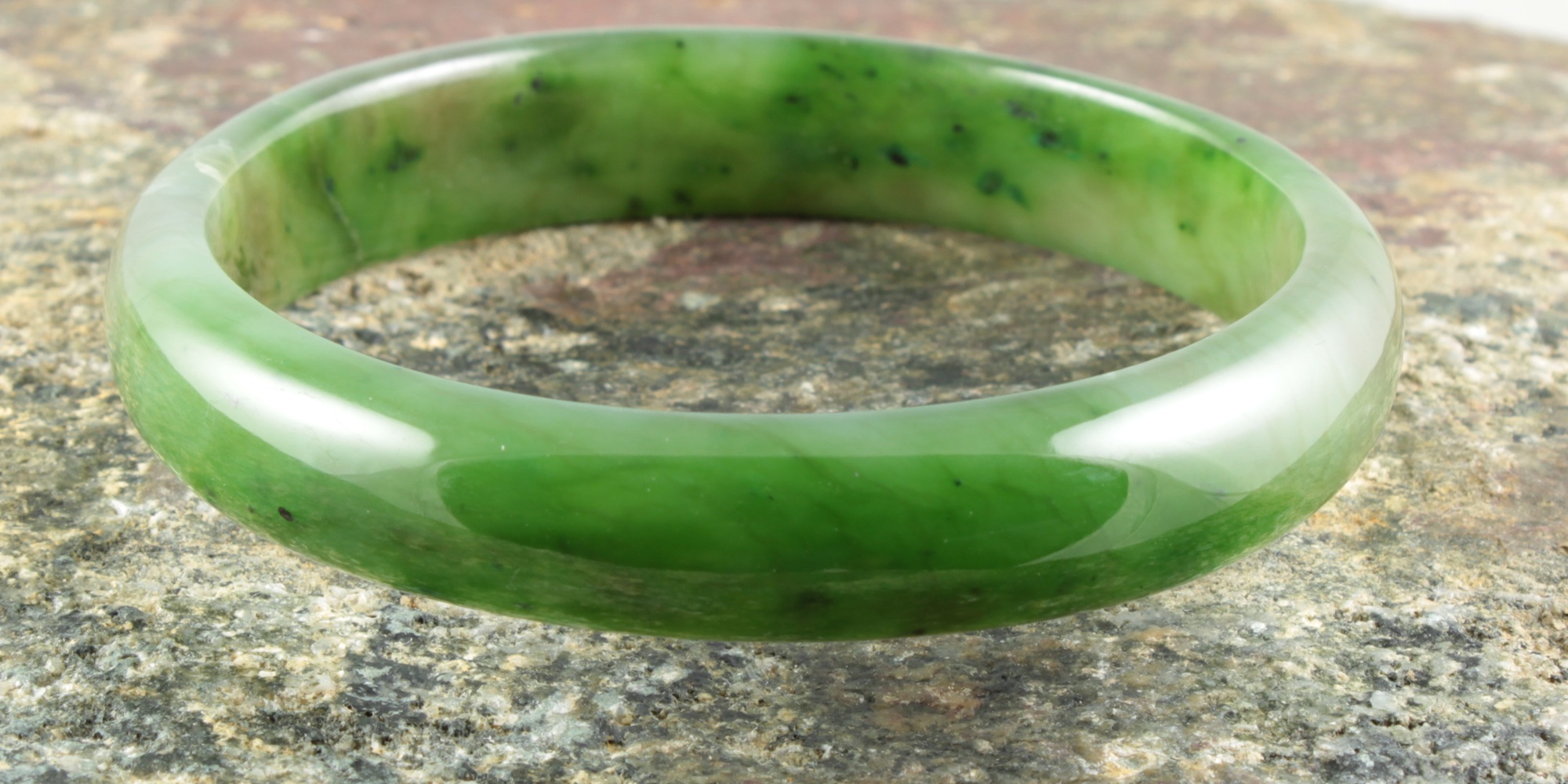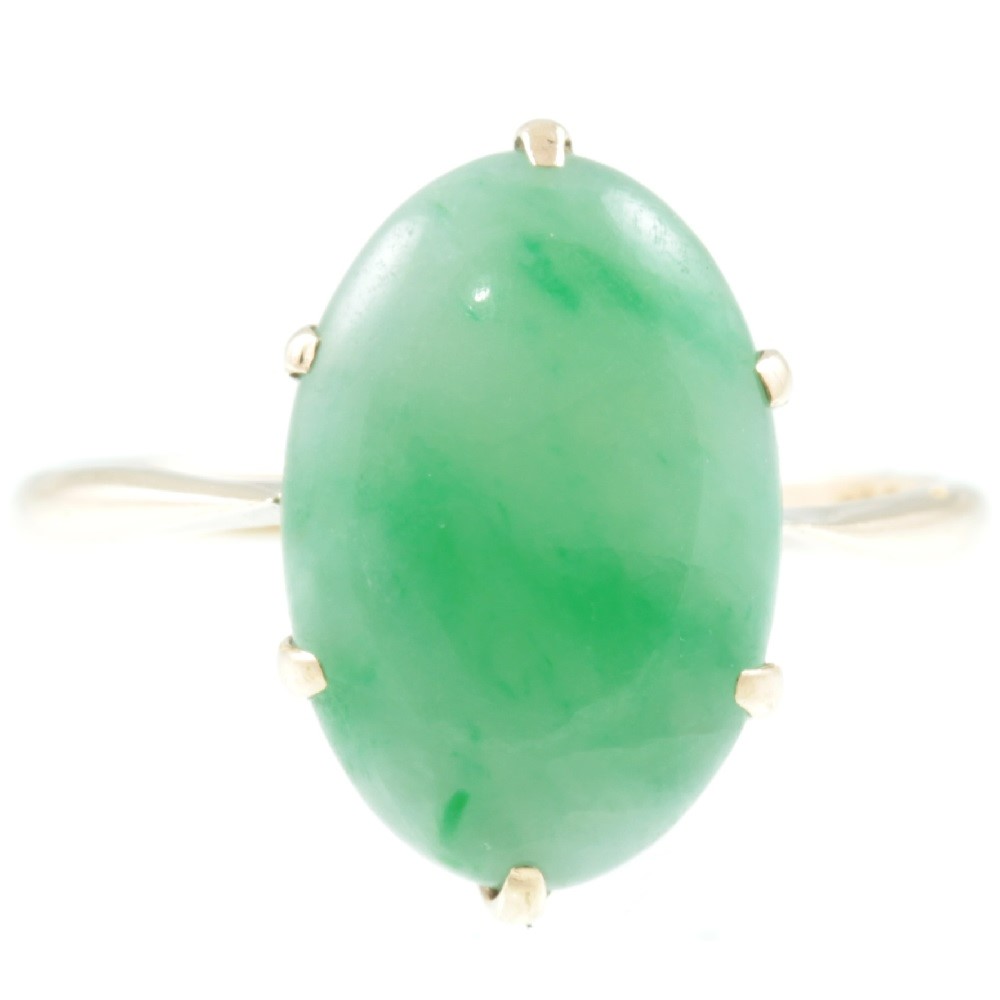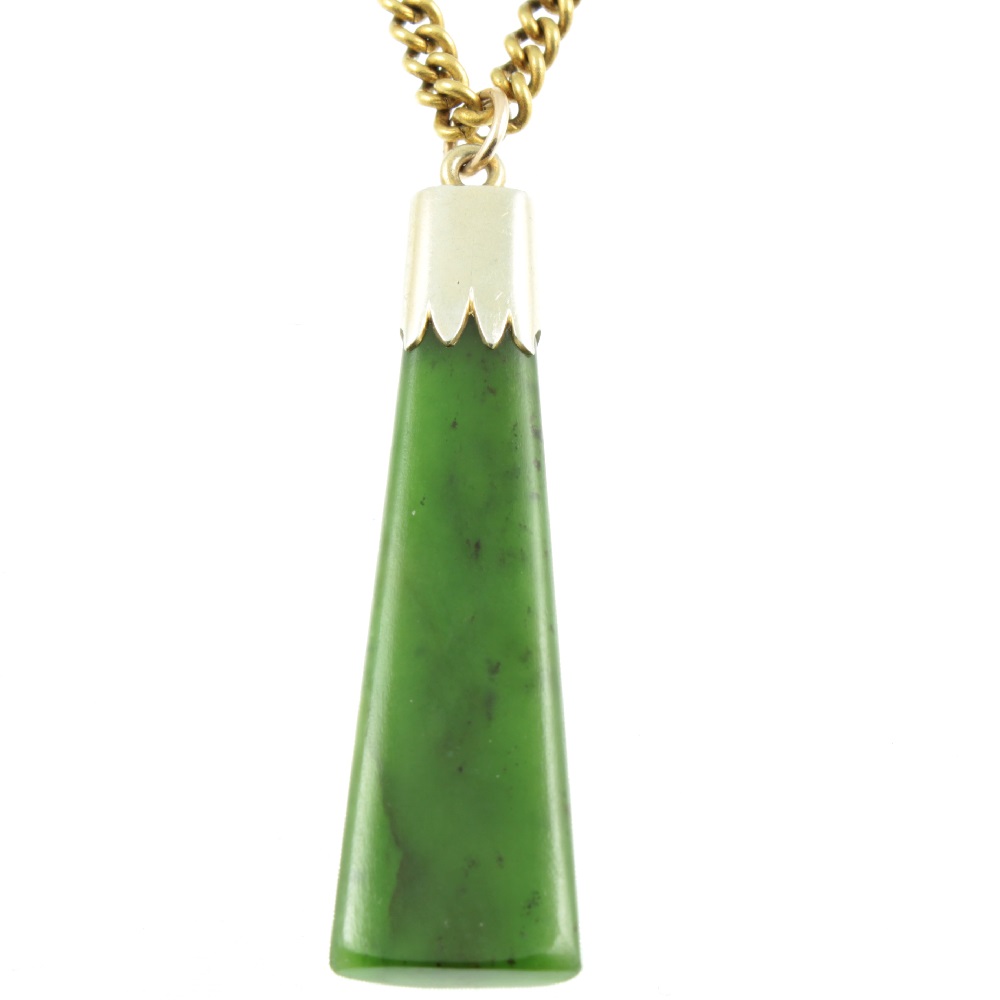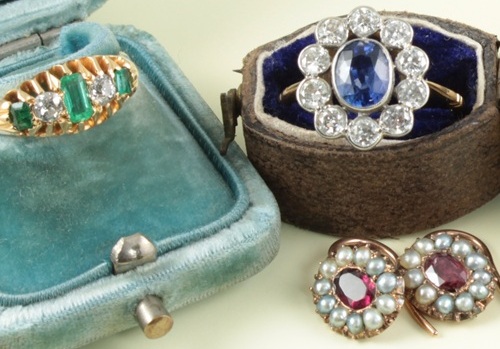Jade
The name Jade originates from the time of the Spanish conquest of South America and is derived from the phrase “piedra de ijada” which means “hip stone”. The conquistadors saw the indigenous people wearing the stone on their sides to either treat or protect them against kidney diseases. The phrase “piedra de ijada” was then translated into French as “l`ejade” and in turn was shortened into English as Jade. The name Jade is the term used for two separate minerals, Jadeite and Nephrite. Of the two, Jadeite is the more valuable and its colours are more vibrant. It is typically a bright, vibrant green or white, however, it can come in all colours. While Nephrite is more abundantly found, its colour is more muted with darker shades of green, yellow, brown, and white.
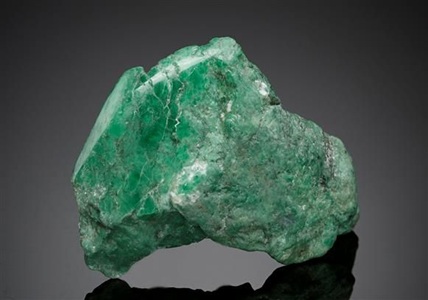 Formation:
Formation:
Jadeite – Jadeite is composed of sodium aluminium silicate ( a pyroxene ) and is formed in subduction zones. This is where two oceanic tectonic plates meet and one tectonic plate is forced beneath the other. This environment creates immense pressure while the temperature remains relatively low. The mineral-rich liquid in the subducting plate is forced upwards under intense pressure. The liquid will then accumulate in cracks and fissures in the above host rock and begin to crystallise into Jadeite. Over time, as the subduction of the tectonic plates continues, the top Jadeite-bearing layer is brought to the surface.
Nephrite – Nephrite is composed of calcium magnesium iron silicate ( an amphibole ). Nephrite is formed through metamorphism, which is the recrystallisation of existing gemstones such as serpentine, tremolite or actinolite. The process requires intense heat and pressure, whereby hot calcium-rich liquid is forced up through cracks and fissures in the host rock. The calcium-rich fluid then reacts with the minerals present in the host rock, transforming them into Nephrite. Nephrite is typically found along ancient or active subduction zones.
Treatment: Untreated Jade, particularly Imperial Jade is significantly more valuable than treated Jade. In its natural state, it is also considerably more durable, as some treatments can make this gemstone quite porous and brittle. For Jadeite, there is a grading system: type A, B, C to classify the treatment type which it has undergone. This classification system is typically not used for Nephrite.
Jadeite Type A: This category is for natural, untreated Jadeite. After the stone has been cut and polished, a surface coating of beeswax is applied to fill in any microscopic pores and to improve the stone`s lustre. The use of natural wax does not alter the structure or colour of the stone in anyway and as such is not classed as a treatment.
Jadeite Type B: This category refers to Jadeite which has undergone bleaching. This involves the gemstone being submerged in hydrochloric or sulfuric acid to remove iron stains and/or any oxidation. This bleaching is quite aggressive and leaves the gemstone very porous and brittle. To counter this, the gemstone will then be impregnated under pressure with a polymer. Which fills the micro-voids created by the acid, adding back strength and improving the stone`s lustre. It also improves the stone`s clarity and transparency.
Jadeite Type C: This category refers to Jadeite which has been artificially dyed. This is a commonly applied treatment, which is used to change the colour of the stone or to enhance the existing colour. However, these dyes are typically unstable and as such are prone to fading, particularly if they are exposed to prolonged sunlight. Care must also be taken with these dyed gemstones to avoid allowing them to come into contact with any sources of heat or any household detergents. The process of dyeing is commonly done in conjunction with bleaching, which will lead to a classification of Jadeite Type B+C.
Heat Treatment: Heat treatment can be applied to Jadeite, which will change its colour to orange or red. This heat treatment works on the iron content within the gemstone. Similar to the process by which Amethyst can be changed into Citrine. Note: heat treatment is only occasionally used.
Nephrite: There is generally no treatment applied to Nephrite. Nephrite is an extremely dense gemstone, with a matted fibrous structure. This makes treatments such as dyeing and polymer impregnation largely ineffective. A surface coating of natural wax, typically beeswax is commonly applied to Nephrite but this is not classed as a treatment.
Durability:
Jadeite: Jadeite has a Mohs hardness rating of 6.5 to 7 which makes it suitable for occasional wear. Type A Jadeite would be the most durable and can be worn everyday providing care is taken. Its crystal system which is intergrown, grainy aggregate gives it a very high resistance to cracking, breaking or chipping. Although it can be scratched by other harder gemstones. For this reason, it is always recommended to store it in a soft cloth pouch away from other jewellery. Type A Jadeite is sunlight stable, however type B and C are sunlight sensitive and as such prolonged exposure to sunlight should be avoid.
Nephrite: Nephrite gemstone has a Mohs hardness rating of 6 to 6.5, which makes it suitable for occasional wear. Although its hardness is not very high, it is an extremely tough gemstone due to its intergrown fibrous structure. This gives it a very high resistance to cracking, breaking or chipping. Nephrite is not sensitive to sunlight but can be damaged by high heat.
Meaning and Healing Properties
Jade symbolises longevity, protection and good luck. The stone was said to have the ability to protect the wearer from evil spirits and misfortune, while at the same time ensuring a long and healthy life. Jade was widely believed to bring good luck, wealth and success. In China, the stone symbolised imperial power and nobility, it was known as the “Stone of Heaven”. It was highly prized in China and considered more valuable than gold. The Maori people in New Zealand associated this gemstone with strength and protection. The Aztecs and Mayans also highly prized Jade and associated it with life, fertility and divinity.
Chakra: Jade is associated with the heart chakra, particularly green Jade. The heart chakra promotes love, compassion, emotional well-being and harmony.
Birthstone: Jade is an alternative birthstone for March. The traditional birthstones for March are Aquamarine and Bloodstone.
Zodiac Astrology: Jade is associated with the star signs Pisces, Taurus, Libra and Leo.
Wedding Anniversary: Jade is the traditional gift for the 12th wedding anniversary. Alternative gemstones for the 12th wedding anniversary are Agate and Opal.
History
This gemstone has a very long history dating back to its earliest known use during the late stone-age (Neolithic period). Nephrit was first mined in China around 5,000 BC in the Liaoning province and inner Mongolia by the Hongshan people. It was also mined by the Liangzhu people in the Ningshao area. Nephrite held significant value and status for these ancient cultures, they used it to make objet d`art, ceremonial and burial objects. From the earliest Chinese dynasties, it was considered to be the “imperial gem” and was more valuable than gold. Yearly tribute payments to the imperial court from various provinces would include a quantity of Jade, particularly white Jade which was highly prized.
The earliest mining of Jadeite can be traced back to around 5,000 BC in Japan. Jadeite in Japan was mined in the Itoigawa region. Jadeite has long held significant cultural value in Japan. It was seen as a status symbol and also used in rituals. The Japanese people associated the stone with fertility, life and the earth. Jadeite is the national stone of Japan.
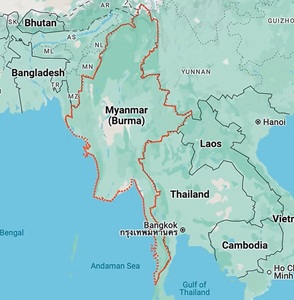 Jadeite mining in Myanmar ( formerly called Burma ) can be traced as far back as the 3rd Century AD. Myanmar`s Jadeite deposits are located in the northern regions and are considered to be the finest Jadeite in the world. Legend has it, that Burmese Jadeite was first discovered by a Yunnan trader who used a large brown coloured stone to counter-balance a mule`s load. When the trader reached his destination in China the stone was broken open and so the beautiful green gemstone was exposed. In its early history, Jadeite was highly prized for its durability and was commonly used to make tools and weapons as well as objet d`art. During the late 18th Century, a peace treaty was signed between China and Burma. This allowed Jadeite to be traded and lead to the establishment of the “Jade Road”. Which operated between the mines in northern Burma and the Yunnan province in China. Today Myanmar is the world`s primary source of high-quality Jadeite, producing an estimated 70% of the world`s supply.
Jadeite mining in Myanmar ( formerly called Burma ) can be traced as far back as the 3rd Century AD. Myanmar`s Jadeite deposits are located in the northern regions and are considered to be the finest Jadeite in the world. Legend has it, that Burmese Jadeite was first discovered by a Yunnan trader who used a large brown coloured stone to counter-balance a mule`s load. When the trader reached his destination in China the stone was broken open and so the beautiful green gemstone was exposed. In its early history, Jadeite was highly prized for its durability and was commonly used to make tools and weapons as well as objet d`art. During the late 18th Century, a peace treaty was signed between China and Burma. This allowed Jadeite to be traded and lead to the establishment of the “Jade Road”. Which operated between the mines in northern Burma and the Yunnan province in China. Today Myanmar is the world`s primary source of high-quality Jadeite, producing an estimated 70% of the world`s supply.
Nephrite mining in British Columbia can be traced back thousands of years. The indigenous people who lived there used Nephrite to make both tools and ceremonial items. In 1858, during the Fraser river gold rush European prospectors did find Nephrite but they considered it to be worthless. However, in 1886 Chinese gold prospectors recognised the gemstone and its commercial value. Large-scale commercial mining of Nephrite began in the 1960s and 1970s. In 1986 China opened to foreign trade, which lead to a boom in Nephrite exports from British Columbia that continues to the present day. Currently, it is estimated that British Columbia produces 75% of the world`s Nephrite.
Folklore
Jade holds a very significant place in Chinese culture, where it is often referred to as the “Stone of Heaven”. It was believed to have protective powers, a divine connection, and to be the embodiment of moral virtues. It was said that if a piece of Jade was broken, then the stone was after taking a blow which was intended for the owner and so it protected the owner. During the Han Dynasty, emperors and high-status people were often buried in complete suits of Jade in the belief that it would delay decomposition and even grant them immortality. Confucius compared the moral virtues of the gemstone to a noble person.
In Japan the focus was only on green Jade, other colours of the gemstone were not used. They associated it with fertility, life, and the earth. Legend has it that the Itoigawa region of Japan was ruled by a goddess called Princess Numakawa and that Jade found in her domain held spiritual powers. There is a shrine in Itoigawa to Princess Numakawa and it is said that if you hold her hand while shaking a statue of her in your other hand you will be granted a wish.
Jade was an extremely rare gemstone historically in Europe and was not introduced until around the 18th Century. As such folklore surrounding this gemstone is largely absent from Europe.
Famous Jade

The Jadeite Cabbage
National Palace Museum

The Jade Buddha for universal peace
The Great Stupa of Universal Compassion

Barbara Hutton, Jade Necklace
The Cartier Collection
Jadeite Species Gemological Data
Colour: Green, all other colours.
Colour of Streak: White.
Moh`s hardness: 6.5 – 7
Density: 3.30 – 3.38
Cleavage: Good.
Fracture: Splintery, brittle.
Crystal system: Monoclinic, intergrown, grainy aggregate.
Transparency: Opaque, translucent.
Chemical composition: Na(AI,Fe3+)[Si2O6] sodium aluminium silicate.
Refractive index: 1.652 – 1.688
Double refraction: 0.020
Pleochroism: Absent.
Dispersion: None.
Fluorescence: Greenish, very weak whitish glimmer.
Nephrite Gemological Data
Colour: Green, all other colours.
Colour of Streak: White.
Moh`s hardness: 6 – 6.5
Density: 2.90 – 3.03
Cleavage: None.
Fracture: Splintery, brittle, sharp-edged.
Crystal system: Monoclinic; intergrown fine fibrous aggregate.
Transparency: Opaque.
Chemical composition: Ca2(Mg,Fe2+)5[OH|Si4O11]2 calcium magesuim iron silicate.
Refractive index: 1.600 – 1.627
Double refraction: -0.027
Pleochroism: Absent.
Dispersion: None.
Fluorescence: None.
For Researchers and Journalists
Recommended Citation (MLA) Format:
Hoyne, John. “Jade: Formation, History, Meaning, and Folklore.” Carus Jewellery, n.d., https://carusjewellery.com/jade/ .
You can also get in touch with Carusjewellery.com on Facebook , where you may leave any comments or questions you may have about this article.

